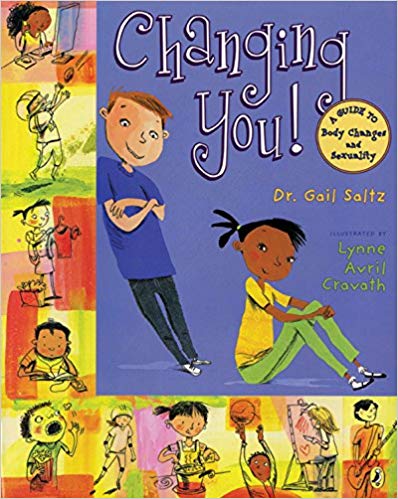STD Testing: Planned Parenthood's Roo Chatbot Answers Your Questions
This video stresses the importance of getting tested for sexually transmitted diseases (STDs) when a person begins to engage in sexual behaviors, such as oral, anal or vaginal sex or genital-to-genital rubbing. While a person should immediately seek STD testing if they have symptoms, getting tested each year—even if a person does not have symptoms—is especially important, since the most common STD symptom is no symptoms. This video also describes the different kinds of testing available for STDs. In addition, it notes that if a person tests positive for an STD, there is nothing to be ashamed of, as STDs are common. The video explains that most STDs can be cured with medicine and those that cannot be cured can be managed with treatment. And finally, the video emphasizes the importance of telling any current or past partners, if a person does test positive for an STD. [AMZ-118]
Youth
You may have heard of sexually transmitted diseases (STDs), also called sexually transmitted infections (STIs). They are more common than most people think and are spread through sexual behaviors with someone who already has an STD. The most common STD symptom is no symptoms at all. Since it is possible for someone who is having oral, anal or vaginal sex or engaging in genital-to-genital rubbing with a partner to have an STD and no symptoms, it is important for sexually active people to get tested.
When a person makes an appointment for an exam, they have to ask specifically about getting tested for STDs, since STD testing isn’t automatically included in a regular medical exam or checkup. STD testing is usually quick and easy. There are different kinds of tests depending on which STD a person is being tested for. There are urine tests, where a person urinates or pees in a cup. A health care provider may also swab or rub the inside of a person’s cheeks with a soft swab to test for HIV, or they may swab the genitals. A health care provider may also take blood from a person’s arm or do quick finger prick. In addition, a health care provider may do a physical examination to check a person’s genitals for symptoms, such as warts, sores or rashes. A person may learn their STD test results right away. In some health centers, people can receive their HIV test results in as little as 20 minutes. Other STD tests may take a few days or weeks to come back.
Since STDs are so common, most people will have one at some point in their lives, so they are nothing to be ashamed of. Most STDs can be cured with medicine prescribe by a doctor. For those STDs that cannot be cured, a health care provider will offer treatment to control the symptoms and reduce the risk of passing the STD on to a partner. If a person finds out they have an STD, they need to share this news with their past and present sexual partners so they can also get tested and treated, if necessary.
STDs are also easy to prevent. If you don’t engage in sexual behaviors, you don’t have to worry about STDs. But when a person does decide to engage in sexual behaviors, condoms and dental dams are highly effective at reducing the risk of getting an STD.
FAQs
Most STD tests are quick, easy and painless. Depending on which STD a person is being tested for, they may urinate or pee in cup or have their genitals or the inside of their cheek swabbed. All of these tests are painless. It is possible a person may get a blood test, where a health care provide draws blood or does a finger prick. Both of these may involve some quick, temporary discomfort. What is important to keep in mind is that testing—even if it involves some temporary discomfort—is the one way to know if you have an STD and to start treatment if you need it.
Herpes is the only STD that can be passed through kissing. This usually happens when one person has a sore on or around the mouth and then kisses another person. It can also happen during a select number of days throughout the year when the virus is more active in a person’s body and when they may have no symptoms at all.
The only 100-percent effective way to avoid getting an STD is to abstain from sexual touching below the waist, such as rubbing bodies without clothes, vaginal-penile sex, oral sex and anal sex. Your next best bet is to practice safer sex, such as using either a male or female (internal) condom and/or dental dam every time you have any type of sex. Once you start having sex, it’s also important to get tested regularly for STDs and to ask your partners to do the same.
A condom is a thin piece of latex, polyisoprene or polyurethane that is worn over the penis during oral, anal or vaginal intercourse to prevent pre-ejaculatory (pre-cum) fluid or semen from entering a partner’s mouth, anus or vagina. Condoms can be made of latex, polyisoprene, polyurethane and natural skin, but only latex, polyisoprene and polyurethane condoms prevent the transmission of sexually transmitted diseases. Condoms can be found in most supermarkets and drugstores.
Additional Resources
Parents
STDs are diseases, infections or illnesses that can be transmitted from one infected person to another through sexual contact—from sexual touching (genital-to-genital contact) to any kind of sexual intercourse (oral, anal or penile-vaginal sex).
There are many different STDs. Some are not very serious. Others can be very serious. Many people also believe that they will know when they have an STD, when in reality most people who have an STD do not experience any symptoms.
It is common for young people to hear many myths about STDs, so having a trusted adult in their lives that they can talk to about this topic is important. There is also a lot of stigma around having an STD, even though it is quite common to have one at some point in your life.
Even though most people don’t like to talk about STDs, it is important for caring adults to talk with young people about STD transmission and prevention, hopefully before young people begin engaging in sexual behaviors with a partner. While it is good to normalize STDs, it is also important to be clear with young people about how STDs can affect them and why it is important to practice safer sex.
Before young people begin engaging in sexual behaviors, they should know how they can reduce the risk of contracting an STD by decreasing their number of sexual partners, getting tested before sexual activity, and properly and consistently using latex barriers, like condoms, female (internal) condoms and dental dams. Research shows that young people whose parents talked to them about condoms before the young person began having sex are more likely to use condoms at first intercourse and thereafter.
It’s also very helpful for young people to know how to get tested once they begin having sex. STD testing and treatment is offered through your family doctor or at most family planning clinics and community health centers. STD testing often involves either a urine test, a simple blood test or a mouth swab. Young people should understand that many STDs can be treated with medicines provided by a doctor, but there are some STDs that cannot be cured.
Talking about STDs with the young people in your life lets them know that they are not alone and that they can come to their parents or guardians when they have questions or need support.
CONVERSATION STARTERS
If you start essential conversations about topics like STDs with your children, then they will know they can come to you with questions. The easiest way to start these conversations is to talk about issues as they arise in everyday life while you are doing things like watching TV together. Symptoms, testing and condoms may not just come up in conversation, but it is important to talk about these issues. Below are some ways to start these conversations:
For example, if a sex scene comes up on TV, there is an opportunity to talk about whether the partners talked about safer sex or used a latex barrier, like a condom or dental dam. While you may be nervous about having these conversations, a simple, “Wow, do you think they’re worried about STDs or HIV?” is one way to start the conversation.
If you are shopping together in the market or drugstore, walk up the aisle where the condoms are hanging and ask your child if they know what condoms are and how they are used. Purchase a pack to take home and open so your child can see what they look like and how they are used.
Educators
STDs are diseases, infections or illnesses that can be transmitted from one infected person to another through sexual contact—from sexual touching (genital-to-genital contact) to any kind of sexual intercourse (oral, anal or penile-vaginal sex).
There are many different STDs. Some are not very serious. Others can be very serious. Many people also believe that they will know when they have an STD, when in reality most people who have an STD do not experience any symptoms.
It is common for young people to hear many myths about STDs, so educating them about this topic is very important. There is also a lot of stigma around having an STD, even though it is quite common to have one at some point in your life.
Education about STD transmission and prevention should start hopefully before young people begin engaging in sexual behaviors with a partner. While it is good to help young people understand that STDs are relatively common, it is also important to be clear with young people about how STDs can affect them and why it is important to practice safer sex.
Before young people begin engaging in sexual behaviors, they should know how they can reduce the risk of contracting an STD by decreasing their number of sexual partners, getting tested before sexual activity, and properly and consistently using latex barriers, like condoms, female (internal) condoms and dental dams.
It’s also very helpful for young people to know how to get tested, if they think they might have an STD. STD testing and treatment is offered by most family physicians and at family planning clinics and community health centers. STD testing often involves either a urine test, a simple blood test or a mouth swab. Young people should also understand that many STDs can be treated with medicines provided by a doctor, but there are some STDs that cannot be cured.
Educating young people about STDs lets them know that they are not alone and that they can ask questions or seek help when they need it.
It is common for young people to hear many myths about STDs, so educating them about this topic is very important. There is also a lot of stigma around having an STD, even though it is quite common to have one at some point in your life.
Education about STD transmission and prevention should start hopefully before young people begin engaging in sexual behaviors with a partner. While it is good to help young people understand that STDs are relatively common, it is also important to be clear with young people about how STDs can affect them and why it is important to practice safer sex.
Before young people begin engaging in sexual behaviors, they should know how they can reduce the risk of contracting an STD by decreasing their number of sexual partners, getting tested before sexual activity, and properly and consistently using latex barriers, like condoms, female (internal) condoms and dental dams.
It’s also very helpful for young people to know how to get tested, if they think they might have an STD. STD testing and treatment is offered by most family physicians and at family planning clinics and community health centers. STD testing often involves either a urine test, a simple blood test or a mouth swab. Young people should also understand that many STDs can be treated with medicines provided by a doctor, but there are some STDs that cannot be cured.
Educating young people about STDs lets them know that they are not alone and that they can ask questions or seek help when they need it.
- According to the video, what are some reasons why a person would want to get tested for sexually transmitted diseases (STDs)?
- What were some of the different types of STD tests described in the video?
- Did any information in the video surprise you?
- What would you tell a friend who wanted to be tested but wasn’t sure how to go about it?
National Sex Education Standards
Access medically accurate sources of information about gender, gender identity, and gender expression
Identify credible sources of information about puberty and personal hygiene
Identify medically accurate sources of information about STDs, including HIV, such as local STD/HIV prevention, testing, and treatment resources
Access credible sources of information about sexual orientation
Access credible sources of information about sexual orientation
Identify medically accurate sources of information about and local services that provide contraceptive methods (including emergency contraception and condoms) and pregnancy options (including parenting, abortion, adoption, and prenatal care)
Identify medically accurate sources of information about and local services that provide prevention, testing, care, and treatment of STDs, including HIV, including the steps to obtain PrEP and PEP
International Technical Guidance on Sexuality Education
International Technical Guidance on Sexuality Education (ITGSE)
Understanding, Recognizing and Reducing the Risk of STIs, including HIV
Understanding, Recognizing and Reducing the Risk of STIs, including HIV




